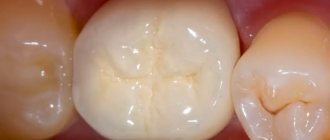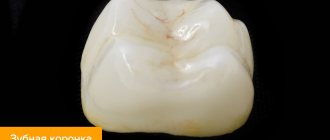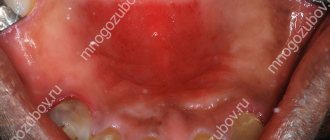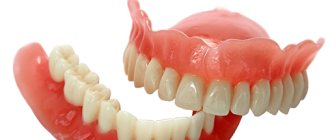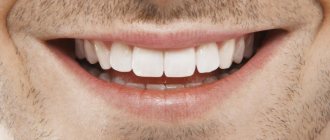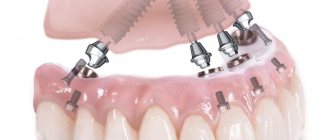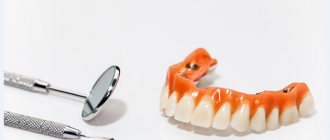A beautiful smile undoubtedly matters to a person. After all, this is what many people fix their attention on when they meet. A smile leaves an unforgettable impression on the interlocutor. It plays an important role in your confidence when communicating. A beautiful smile will improve contact with your interlocutor, improve behavior and leave behind all sorrows and self-doubt, and will also melt the heart of any stranger. But if the smile is not perfect and there is a defect in the front teeth (cracked dental plate, extracted tooth, crooked bite or tooth fragment, caries), how can we talk about self-confidence? Such a person will become isolated from others, become withdrawn, stop smiling, and will feel awkward when communicating. All this can leave a mark on a person’s profession and on his personal life.
No one wants to show problems with their front teeth to others, so dentures are the best solution for such patients.
When performing prosthetics after removal, it is important to restore and preserve the functions of the organ:
- Correct bite;
- Shape;
- Natural color;
- Gum health.
Prosthetics of the front teeth is also an aesthetic issue, therefore, to create a beautiful smile, it is necessary to use high-quality, durable materials that will visually look good. In dentistry, several methods of installing dentures are used and leading materials are used to give each patient a dazzling smile.
The main indications for the use of anterior dental prostheses are:
- Cracks in the dental plate, chips, broken teeth;
- Lost teeth or congenital adentia;
- Carious teeth;
- Crooked bite;
- Yellowing or darkening of the enamel;
- Crooked teeth, irregular shape and uneven “facial” surface of the tooth;
- Early unsuccessful prosthetics.
To solve your problem and select the correct method for installing dentures after removing your front teeth, you can consult the Dr. Levin dental clinic by calling the clinic.
What prostheses can be placed in the smile zone - the most complete list of solutions and their features
Article navigation
- Indications for prosthetics
- Important Features
- Prosthetic options
- Removable prosthetics
- Fixed dentures
- Implantation of incisors and canines
- Which dentures are better?
- Which material to choose
- In what situations is enamel grinding not necessary?
- Periodontitis and periodontal disease
- Contraindications
- Dentists' recommendations
- Price
Question for a specialist
People practically do not use incisors for chewing food, which is why when restoring them, high demands are placed mainly only on aesthetics and restoration of the correct bite. It is very important that your smile looks natural and natural. However, the material must still be strong enough to withstand the average load of biting food. Because of all these features, prosthetics of the front teeth contains many nuances, which will be discussed further.
How to choose a good doctor
Finding a doctor who will restore chewing functions is a responsible task. The qualifications of a specialist directly affect the quality of the work performed, the durability of the structure and the impressions after visiting the doctor. A doctor must combine a master of his craft and a good psychologist in one person. Many people are afraid to go to the dentist, so to create a comfortable environment for the patient, the dentist must be friendly, not fuss, and explain the stages of work. Then your visit will leave only pleasant impressions.
A professional must know: how they are made, from what material removable and permanent dentures are made, and understand the types of fasteners with classification.
The most proven way to find a dentist is to collect reviews from friends. You can also use comments about specialists and clinics involved in bite correction from the Internet. For many years, the Dentika dental center has received only positive reviews from its visitors. The main goal is to make the reception pleasant, high-quality, person-oriented with a mandatory personal approach (to bring joy and health to every patient who comes to us).
At your appointment, you can ask the doctor to show all types of modern materials for high-quality complete dental prosthetics.
Indications for prosthetics in the smile area
When thinking about prosthetics for the upper or lower front teeth, you need to know in what cases it is necessary. It is clear that the complete absence of an incisor or canine tooth along with the root is a direct indication for prosthetics. But there are other cases when it is a prosthesis in the classical sense that is needed, and not a filling. Let's look at the main indications for prosthetics in the smile area:
- chipped crown: the defect is more than half of its original size,
- cracks in the enamel or its abrasion,
- malocclusion: only in case of minor pathologies it is corrected with dentures, otherwise braces/aligners (orthodontic aligners) are needed,
- frequent caries under fillings,
- enamel defects: darkening, smoker’s plaque, “tetracycline” staining, fluorosis, thin enamel layer,
- complete absence of a tooth along with the root.
That is, prosthetics are necessary to recreate the aesthetics and functionality of a smile, as well as to create a more attractive appearance. The latter is especially true for public people and women.
Important features of restoration of incisors and canines
Features of prosthetics of the anterior teeth of the lower and upper jaw are as follows:
- it is important to recreate the aesthetics of the smile and face: choose the right shape and color of dentures that are identical to the enamel of neighboring units of the dentition,
- it is important to pay attention to the position of the gums: the contour of the mucous membrane should be natural and natural,
- it is important to ensure good fixation of the prosthesis: so that a person can not only smile, but also bite and chew food normally (although biting off very hard foods will no longer be possible in any case),
- It is important that the restoration does not cause discomfort and does not provoke pathologies: allergies or inflammation.
Only until December 25 South Korean implant Osstem - from 18,500 rubles.
Hurry up to sign up for a free consultation and lock in promotional prices.
Call now or request a call
Opening hours: 24 hours a day - seven days a week
Removable prosthetics and its features
- When to use: if one or more front teeth are missing along with the roots, that is, they are completely removed.
The peculiarity of removable dentures is that they are fixed to the supporting teeth with hooks (clasps). These clasps are noticeable when you smile (if the hooks are made of metal) or often become loose and break (if the clasps are made of plastic). The attachments can damage the enamel of the supports or the surrounding gums, causing inflammation. By the way, this can also include a rapid decline in aesthetics, because plastic teeth quickly darken from plaque, and it will not be possible to whiten them to an ideal state.
Most often, a removable butterfly prosthesis is placed on the front teeth (if the chewing ones are preserved) - and only as a temporary solution. In other cases, in order to also partially restore the chewing teeth, you will have to make a massive prosthesis with a voluminous plastic palate or gum - this way it will hold better, but with less comfort.
In orthopedic dentistry, there are the following types of removable dentures:
- acrylic: made of long-known and inexpensive acrylic plastic,
- Acry-free (“Acry-free”): a modern variation of the previous type. Made from plastic that contains virtually no acrylic monomer (somewhat a toxic substance found in conventional acrylics),
- polyurethane: Russian alternative to nylon structures. The material is soft and flexible,
- clasp: unlike all the others, clasps have a metal arch, which adds rigidity and more correctly distributes the chewing load. The upper palate is not made solid, but in the form of a small bridge, which increases wearing comfort. Clasp ones will be placed only if at least part of the lateral teeth is missing, otherwise they simply cannot be fixed,
- Quattro Ti (“Quadrotti”): similar to clasp ones in structure and scope, but “Quadrotti” do not have a metal arc. They are made only from Dental D material (a combination of nylon and plastic), patented by Quattro Ti.
To read about each individual type of prosthesis, click on the name to go to the corresponding page with a description.
Prosthetics with zirconium crowns –
The next option for aesthetic prosthetics of the front teeth is ceramic crowns made of zirconium dioxide (such crowns are called zirconium). This material has the strength of metal, and therefore crowns made from it do not require an internal metal frame. The absence of the latter should certainly provide more aesthetic options when using prosthetics with zirconium crowns, but in reality, not everything is so simple, and you can find a huge number of patients who are dissatisfied with such prosthetics.
Let's start with the fact that there are 2 types of zirconium crowns.
- The first option assumes that only the internal frame reinforcing the structure is milled from zirconium dioxide, which will then be covered with layers of ceramic mass (porcelain). The disadvantage of this option is that the porcelain often chips. According to statistics, after 3 years, chips occur in at least 6% of patients with zirconium crowns, and after 5 years – in at least 10% of patients.
In addition, if for this version of crowns a cheap version of zirconium dioxide blocks is used (milky white, not transparent, i.e. translucent), then even after applying layers of porcelain, the crowns end up looking unnatural, because have a milky tint.Clinical case No. 4 –
Note the unnatural color (no color gradient from the neck of the tooth towards the incisal edge of the incisors) that is present on adjacent teeth. In addition, there is no transparency of the cutting edges, i.e. crowns essentially look like plastic. Keep in mind that in most clinics in our country, zirconium crowns are made at approximately this low professional level.
- The second option is monolithic zirconium crowns “Multi-layer”. Monolithic - means that the crowns will be made entirely of zirconium dioxide, i.e. without applying layers of porcelain (accordingly, in this case there is no problem of ceramic chipping). But the most important thing is that in this case more expensive “Multi-layer” zirconium dioxide blocks will be used.
Such blocks have a gradient of color and transparency, which makes it possible to mill crowns from them, which will also have a gradient of color and transparency, varying from the neck of the tooth and towards the incisal edge. Accordingly, the presence of a gradient of color and translucency will make the crowns on the front teeth more similar to real ones.Clinical case No. 5 (multi-layer) –
In the photo above you can see newly made “Multi-layer” zirconium crowns, which still need to be fixed in the oral cavity. The crowns are made for the entire dentition - they are single crowns, with the exception of a 3-unit zirconia bridge in the side of the jaw (where you can see the artificial pink gum). Pay attention to the natural color and transparency that change - in the direction from the necks of the crowns to the cutting edge.
Is it worth it or not to make zirconium crowns?
Everything will depend on the specific situation in the oral cavity. In general, zirconium dioxide crowns are a good choice if you need to replace an entire group of front teeth at once (for example, 6-8 or more). This is because the dental technician only has a limited range of color options when working with zirconia. Those. If you have a complex tooth color, then one or more crowns will almost always differ from your neighboring natural teeth.
But this problem is solved if you do all the front teeth at once, in which case they will all look the same. And in this case, of course, you should pay attention to the fact that the crowns are made monolithic - from “Multi-layer” zirconium dioxide blocks, and not from cheap milky-white blocks that are not translucent. BUT, again, sometimes you have to deviate from this rule if the patient only needs 1-2 single crowns on the front teeth.
In this case, only the frame is milled from “Multi-layer” zirconium dioxide blocks, and then layers of porcelain are applied to it. Despite the higher risk of chipping, this technology will allow the dental technician to make crowns more similar to neighboring teeth, because When working with porcelain, the dental technician has a much wider range of color options. The main thing here is that cheap milky-white zirconium dioxide, which does not have translucency, is not used for the frame of the crowns.
The cost of zirconium crowns - the cost of 1 zirconium crown averages from 30,000 to 40,000 rubles. In the regions you can find prices starting from 25,000 rubles, but for this price the crowns will be made of cheap zirconium dioxide of a milky white color, which is not translucent. At the same time, we will next tell you about Emax ceramic crowns, the price of which averages from 25,000 to 30,000 rubles, and this despite the fact that they also benefit in aesthetics.
Zirconium dioxide with increased aesthetics:
Clinical case No. 6 –
Clinical case No. 7 –
When choosing ceramic zirconium crowns for your front teeth, you must ask your doctor for information about the manufacturer of the zirconium dioxide blocks from which your crowns will be milled. These should be translucent/pre-colored zirconium dioxide blocks (“multi-layer”) - preferably such as Katana® UTML (Japan) or Prettau® Anterior (Germany).
For more information about the various options for manufacturing zirconium crowns, read the article: → Options for manufacturing zirconium crowns, prices"
Fixed dentures to restore the smile area
- When to use: if teeth have lost their aesthetics, are partially destroyed, there are chips - these are indications for installing veneers or crowns. If the teeth are missing along with the roots, then bridges are placed.
Fixed ones correspond to almost all features of prosthetics, since they are highly aesthetic, are well fixed, and the absence of plastic gums and palate makes wearing them quite comfortable. But all this provided that an experienced orthopedist was involved in the prosthetics, high-quality materials and technological equipment were used.
%akc72%
The advantage of non-removable ones is that they last much longer than removable ones. Fixed ones do not move, they do not need to be taken out of the mouth to clean (and the person will not forget to put them back), they do not need to be glued to the cream, and there is no need to get used to a foreign object in the mouth. The disadvantages include the cost, which is significantly higher than that of removable ones.
Aesthetic prosthetics – veneers, lumineers, ultraneers
Veneers, lumineers and ultraneers are durable and aesthetic microprostheses for the smile area; they are installed only on the front part of the dentition and mask minor defects, creating a “Hollywood smile”. They can cover cracks in the enamel, small chips, interdental spaces (diastemas and trema), and slightly level the inclination of the teeth.
Veneers (in fact, lumineers and ultraneers are also veneers) are presented in the form of thin ceramic overlays. Their thickness varies between 0.3-0.6 mm. And if ultraneers are just thin veneers (0.3 mm), then lumineers are already a patented brand with its own manufacturing technology (the thickness of lumineers is about 0.2 mm). You can evaluate the aesthetics of lumineers restoration using photos before and after prosthetics of the front teeth.
Among the positive aspects of veneers are the highest aesthetics and durability (10-20 years of trouble-free wear). The disadvantages include very careful operation of the restoration, high cost, and the need to install 6-8 veneers or lumineers per row at once. But in the case of classic veneers, it is possible to replace one or two front teeth.
Traditional prosthetics with crowns
If the top is destroyed by more than half, but the roots are intact, it is recommended to use dental crowns.
A crown is a cap-shaped prosthesis that restores a single defect and is placed on some kind of support. It perfectly follows the shape of the natural tooth apex and is fixed very firmly with special cement. But it is rarely possible to remove a crown without damaging it, for example, to treat root canals or periodontitis. In this case, you have to make a new one. And after several removals/fixations, a situation often arises that the root has to be removed (if it is severely damaged due to caries or frequent treatment). Then it is no longer possible to install a crown; you have to look for other prosthetic options.
To fix the crowns, a certain support is required:
- the preserved part of the natural tooth apex: it is previously ground down to give the shape of a stump or a truncated cone,
- post: a metal screw that is secured into the tooth root. The advantages of the method are low price, the disadvantages are uneven load on the root, insufficient fastening reliability,
- stump tab: a more successful (but also expensive) analogue to a pin. The inlay can be made of durable metal-free materials, the shape exactly follows the cavity inside the root and rises above the gum so that the crown can be fixed to it. Metal-free materials transmit light in a similar way to natural tooth enamel. This option looks more aesthetically pleasing and will last many times longer than pins.
Bridges
They are used when 1-4 teeth are missing in a row. A necessary condition is the presence of supports (or their healthy roots) along the edges of the defect.
Bridges (or bridges) are several crowns connected in a row. Bridges differ from single crowns in that they do not have holes at the bottom and rest on the gums, and the outer ones are created for fixation on supports. Also, “wings” – located along the edges of the bridge – can be attached to these supports.
Adhesive bridges1 have just such “wings”. These bridges are temporary, but are fixed quite reliably (they can come off due to chewing gum or very hard food). The installation can be performed on children and adults - on a temporary basis while awaiting implantation, for example.
The advantages of bridges include high aesthetics, long-term fixation and comfortable operation. But they have a very big drawback - the need to grind down the supports and remove their “dental nerves”. These factors, plus additional chewing load, lead to rapid failure of the supports. You have to re-treat them, and eventually remove them - and each time you need to redo the bridges or make new ones. As a result, when the defect becomes very extensive, you will have to completely abandon bridges in favor of other types of prosthetics.
Another significant disadvantage is that when wearing bridges (as well as removable structures), the bone will constantly atrophy under the plastic base or “empty” crowns. Along with the bone, the gums also recede, making the smile unattractive and allowing food to accumulate in the space between the denture and the gums. After every few months of wearing it, you have to go to an orthopedist and adjust the displaced prosthesis.
Prosthetic replacement of anterior tooth after extraction
After tooth extraction, it is better to do its prosthetics using the express implantation technique, in the absence of contraindications. To do this, immediately after tooth extraction, an implant and a special abutment are installed in its alveolar socket to form the correct gum shape. A crown is temporarily placed on it. After the implant has healed for approximately several months, a permanent crown is installed.
The advantages of express implantation include:
- This procedure does not require any additional incisions, which is less traumatic to the gums;
- The implant is installed in an open manner, which also does not require additional surgical intervention;
- This method is perfect for patients who do not want to wait until the hole heals and a bridge or crown can be installed.
- Short healing period;
- There are few side complications that are unpleasant for the patient.
Implantation of incisors and canines – installation of 1 crown and bridge on implants
- When to use: in the absence of any number of teeth on any of the jaws. These may be single or isolated defects; an entire segment or all teeth may be missing at once. You can even place an implant in the hole of a recently removed tooth root.
An implant is an artificial metal root that is fixed in the bone tissue if there is no tooth root in it. When restoring anterior teeth, it is recommended to install a white aesthetic abutment made of zirconium dioxide. It also corrects the position of the gums, which allows you to achieve ideal aesthetics.
Today, the most ideal method of prosthetics in dentistry is dental implantation. It is suitable for any area of the dentition, with any number of defects - from single and scattered to complete edentia. The most significant advantages of implantation look like this:
- no need to grind down adjacent teeth,
- the highest possible aesthetics – crowns on implants are completely indistinguishable from natural teeth,
- very strong fixation of the implant in the bone and the crown on the implant itself,
- ability to withstand good loads: but the frontal zone should not be overloaded,
- materials for implantation are biocompatible with the body,
- implant-supported dentures have the highest wearing comfort,
- the service life of the implant is eternal, and the prosthesis on it will last at least 15-25 years,
- implants help rebuild the bone around them, maintaining gum level.
Crowns or bridges are placed on top of the implants, as well as bridges with small inclusions of artificial gum (to mask the uneven contour of the natural gum).
Installation of dentures for anterior teeth without turning
This is the restoration of damaged teeth, when the neighboring teeth intended for support are not ground down or depulped. In this case, it is worth performing implantation. This is one of the most gentle and atraumatic methods of installing upper and lower teeth. The essence of the method is that in the place of the lost tooth, an implant is installed in the jaw bone tissue, which performs the function of a root. Subsequently, a crown is put on it.
There are also methods that do not require grinding of a layer of healthy teeth, but they are rather temporary.
To summarize: which prostheses are better?
Which prosthesis is better to choose for prosthetics of front teeth? Let's summarize all the information already available and determine the optimal solution.
| Problem | The best decision |
| If 1 tooth is missing with a root | The crown on the implant will last from 15 years, and the service life of the implant is decades |
| If several teeth are missing | A segment or several crowns, again installed on implants |
| If the top is chipped | If the chip is small - less than 30% of your own enamel, then a veneer is placed. If most of it is missing, a crown on a pin or stump tab |
| If the top is destroyed | If the roots are healthy and intact, then a crown is placed on the stump tab. If the roots are destroyed, they are removed and an implant is placed. |
What material to choose for dentures in the smile area
- plastic and metal-plastic: the most affordable option, but has poor aesthetics and a short service life, therefore it is used only as a temporary solution,
- metal ceramics: a durable and inexpensive option, but not aesthetically pleasing enough for the smile area. In addition, if the metal comes into contact with the gum, it will turn blue over time - this will be noticeable,
- solid ceramics: looks as natural as possible and is quite durable, especially provided that in the frontal area the load on the teeth is minimal,
- Zirconium dioxide or aluminum oxide: the most preferred option, natural, strong and durable. But also the most expensive.
When is metal ceramics used?
Metal-ceramic crowns are one of the most popular options in orthopedic dentistry. It is used quite often because it has an affordable price, high strength and aesthetics. However, they are best used to restore the masticatory sections, but not the anterior ones.
The disadvantages of metal ceramics are as follows:
- may cause allergies: in this case, the cobalt-chromium alloy can be replaced with gold, but the cost of treatment will increase significantly,
- when metal and gums come into contact, “cyanosis” of the mucous membrane may occur,
- your own tooth enamel must be sharpened,
- Mandatory nerve removal is required, even if the root canals are healthy.
When to use ceramics
A more preferable option for the frontal zone. Moreover, modern ceramics have become stronger and more durable. Such dentures are distinguished by natural translucency, the ability to select the shade of ceramics in full accordance with the color of natural enamel. They do not cause blue gums and require minimal grinding of the own enamel, while the dental nerve (if indicated) can be preserved. The only drawback is that they are higher in price than metal-ceramic ones. In addition, it is not advisable to fix them on implants or pins - a metal base can lead to splitting of the structure. Solid ceramics are attached only to your own tooth or core inlay.
When is zirconium dioxide used?
Zirconium dioxide or aluminum oxide are durable materials that are processed using modern computerized equipment. CAD/CAM technology is used to create a customized prosthesis, as well as scanning the entire oral cavity and modeling structures in a computer program. This allows you to achieve incredible precision at all stages of prosthetics. Among the main advantages are the longest service life (from 15-20 years), incredible aesthetics of both the restoration itself and the gum area, the absence of allergic reactions and minimal grinding of the enamel.
Not only crowns and bridges, but also veneers can be made from ceramics and zirconium dioxide.
Don't know what type of prosthetics to choose?
We will help in the selection, advise where to read more information and compare types of prosthetics.
Consultation with an orthopedic doctor in Moscow clinics is free! Call now or request a call
Working hours: from 9:00 to 21:00 - seven days a week
How to replace teeth with missing molars: bridge
A bridge is the only applicable method of permanent prosthetics in the absence of several adjacent teeth. It consists of connected crowns, the outer ones are put on healthy teeth (close to those that are missing).
The need to grind down the supporting teeth is the main disadvantage of this type of prosthetics, which often forces patients to look for other methods. Today bridges are secured in alternative ways:
- on metal plates;
- using a special adhesive.
Crowns for bridge structures are made from the following materials;
- ceramics;
- metal ceramics;
- plastic.
For the most part, the price of the issue depends on the material from which the prosthesis is made, as well as whether it is necessary to restore one tooth or whether prosthetic teeth are needed in the absence of a large number of them. The cost of one crown in our clinic is from 15,000 rubles. for metal ceramics up to 25,000 rubles. and more for ceramics.
Plastic crowns are installed as temporary crowns. Installing crowns made of plastic on chewing teeth is not advisable - this material is not sufficiently stable, and the crown can easily break.
The service life of a prosthesis depends on the number of missing teeth it replaces: the more crowns it has, the less it will last. On average, you should expect 5-7 years of using a bridge.
Over time, bridge structures become mobile, which can lead to unpleasant consequences:
- bleeding gums;
- exposure of the neck of the supporting tooth;
- food residues getting under the structure.
In what situations is enamel grinding not necessary?
How is prosthetics performed in the frontal area? First, the oral cavity is prepared - caries is treated, tartar and plaque are removed, and if necessary, diseased roots are removed. Then, if you need to place a crown, bridge or veneers, you first need to grind down the supports. After this, impressions are taken (you can also perform a 3D scan of the oral cavity), which are sent to the laboratory. But turning can be avoided if the following restoration options are chosen - lumineers, clasp on hooks, immediate or removable dentures.
Manufacturing of removable dentures
The main steps in the manufacture of upper removable dentures are as follows. They may vary slightly depending on the type and material chosen, but we will consider the removable option:
- an impression is taken, on the basis of which a wax model of the jaw is made;
- a plaster prosthesis is cast in the articulator;
- fitting takes place in the patient’s mouth;
- in the laboratory, the technician makes the final version - a metal frame with bases and crowns made of the selected material and color;
- fitting, fitting in the office, fixation. On average, the work takes up to 2 weeks.
Article Expert
Pak Roman Vladimirovich Dentist-orthopedist, doctor of the highest category
Work experience: more than 29 years
Periodontitis and periodontal disease - is it possible to get dentures with such a diagnosis?
If you have periodontitis and periodontal disease, there are not many options for restoring your smile. For example, it could be a splinting “clasp” that will fix loose teeth, but will not cure periodontitis or periodontal disease. Therefore, these pathologies will have to be treated regularly, although they never go away 100%, especially in the later stages.
The ideal option again is implantation, because... implants are not natural roots on which plaque would accumulate, leading to the progression of periodontitis. Implants even promote the regeneration of your own bone and, accordingly, increase the level of gums. But here it is important to understand that it is often impossible to do without removing the remaining diseased teeth or their roots, because they are the source of infection.
Implantation is the best alternative to prosthetics
If the incisor is removed or the remaining roots are in poor condition and cannot be used for prosthetics, implantation is the best solution. This option is more complex and expensive, but this is the only way to avoid bone tissue atrophy, which is very important.
During implantation, a titanium root is implanted into the jaw bone. The top is covered with a flap of gum. As soon as the regenerative processes are completed and the pin has taken root, a crown is installed.
Implants are the best replacement for lost teeth. They do not allow the gums to sag. They fully participate in chewing food and ensure impeccable aesthetics in the gingival region. You should not be afraid of their installation - all manipulations are carried out under anesthesia, so the patient does not experience pain.
Contraindications for prosthetics
All existing contraindications relate for the most part to fixed prosthetics. Moreover, there are many relative contraindications – those that can be “bypassed” over time. For example, relative prohibitions on the installation of fixed bridges or crowns, as well as implants, are imposed on the following groups of patients:
- children under 18 years of age, pregnant women: this is due to the characteristics of bone tissue and the ban on certain anesthetics,
- for diseases of the oral cavity: caries, pulpitis, stomatitis - first you need to be cured,
- for periodontitis and periodontal disease: with classic removable and fixed prosthetics, as well as with two-stage implantation. BUT! When implanted using one-stage protocols - for example, with basal implantation or all-on-6, these pathologies are not considered a contraindication.
There is, perhaps, only one absolute contraindication for removable orthopedic structures, which, by the way, also applies to non-removable ones - these are very serious mental disorders. Also, absolute contraindications, but for implantation, include the following:
- decompensated diabetes mellitus,
- serious pathologies of the heart and blood vessels, endocrine system,
- malignant diseases in the acute stage,
- tuberculosis, HIV,
- inability to carry out high-quality oral hygiene.
Recommendations from dentists when choosing a prosthesis
When restoring small defects, chips and darkening, it is better to choose thin ceramic veneers or lumineers - they will make your smile beautiful for 15 years or more.
Removable orthopedic solutions in the smile area often lose their fixation, move, provoke allergies and cause difficulty chewing medium-hard food. Therefore, it is recommended to install them only as a temporary option: while the patient waits for the installation of a permanent fixed prosthesis or implant. Here, a defect in a row or a ground stump is masked with a plaster or bridge so that the smile retains its attractive appearance. Biting food with these restorations is not recommended. On an ongoing basis only if there are contraindications to fixed solutions or implantation, as well as financial limitations.
Fixed options for restoring minor dental defects, such as crowns and bridges, are quite popular due to their availability. If the natural crown is destroyed by more than half, then a worthy option is a ceramic or zirconium dioxide crown coated with ceramics. But in the case of a bridge, the patient is not immune from bone atrophy and gum loss under the prosthesis, as well as from overloading the supports.
Therefore, the optimal method for restoring the frontal zone will be implantation, because implants prevent the bone from further atrophying and maintain the aesthetics of your smile for several decades.
By the way, positive reviews from 90% of patients who underwent implantation speak of the highest comfort of life even 10-15 years after prosthetics. While 60% of people who have had classic removable prosthetics or bridges subsequently regret their decision.
Veneers and Lumineers
Veneers and lumineers can be used as aesthetic options for dentures on the front teeth. Veneers are very thin shells of porcelain that are given a color similar to the natural color of the patient's teeth. Veneers completely match the shape of a natural tooth. Such plates are attached to the front surface of the tooth.
Lumineers are transparent and very thin plates about 0.15 mm thick. Placed on the front surface of the tooth. This cosmetic procedure is non-invasive, quick, painless and long lasting.
These qualities determine the indications for the installation of veneers or lumineers:
- Crack and small chip of a tooth;
- Yellowing or darkening of tooth enamel;
- Uneven frontal surface;
- Crooked teeth.
The cost of restoring the smile area
How much does front tooth replacement cost? It all depends on the type of prosthesis, its design, complexity of manufacturing and installation, as well as on the materials and rating of the clinic. For example, restoration of a single defect with a composite veneer costs from 7,000 rubles, with a ceramic veneer – from 15 thousand, and one lumineer costs from 50 thousand.
Prices for metal-ceramic crowns start from 6,500 rubles, for ceramic ones – from 18 thousand, and zirconium dioxide – from 25 thousand. The cost of the bridge is calculated according to the number of crowns. A butterfly prosthesis costs from 12 thousand, a plate prosthesis can be ordered for 15-20 thousand, and clasp prostheses, Acri-free and Quadrotti cost from 35-40 thousand rubles. Installation of 1 implant on a turnkey basis, i.e. together with the crown, it will cost at least 35-40 thousand rubles - this is the most budget option, and premium brands cost 2-3 times more.
- Ervandyan A. G. Clinical and laboratory justification for the use of adhesive bridges made of ormokers and fiber materials: Dis. Ph.D. honey. Sci. Moscow, 2005. - 140 p.

